Transcend SSD320 & SSD720 (256GB) Review
by Kristian Vättö on January 25, 2013 11:31 AM ESTRandom Read/Write Speed
The four corners of SSD performance are as follows: random read, random write, sequential read and sequential write speed. Random accesses are generally small in size, while sequential accesses tend to be larger and thus we have the four Iometer tests we use in all of our reviews.
Our first test writes 4KB in a completely random pattern over an 8GB space of the drive to simulate the sort of random access that you'd see on an OS drive (even this is more stressful than a normal desktop user would see). I perform three concurrent IOs and run the test for 3 minutes. The results reported are in average MB/s over the entire time. We use both standard pseudo randomly generated data for each write as well as fully random data to show you both the maximum and minimum performance offered by SandForce based drives in these tests. The average performance of SF drives will likely be somewhere in between the two values for each drive you see in the graphs. For an understanding of why this matters, read our original SandForce article.

Random read performance is typical SandForce. The SSD320 comes in slightly slower, but the difference is a mere 3.9MB/s compared to SSD720.

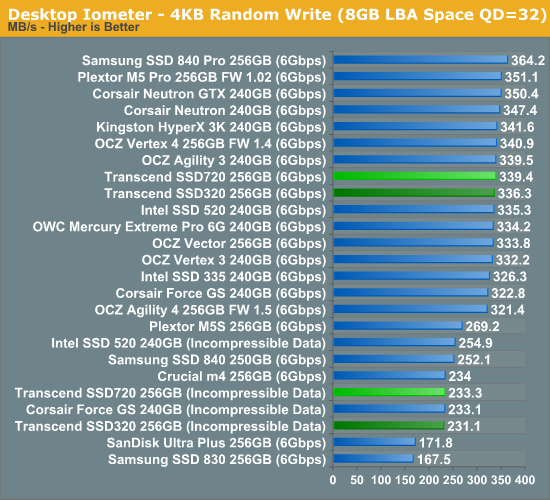
Same story with random write speed; the SSD720 performs hand in hand with Corsair's Force GS (except in QD32 test with compressible data, but Corsair had some issues with that particular aspect), though this is hardly a surprise given that they use identical NAND and the same stock firmware from SandForce. Due to SandForce's real-time compression, the slower NAND in SSD320 only shows up when the data is fed with incompressible data -- with compressible data the SF-2281 writes so little to the NAND that something else becomes a bottleneck even with asynchronous NAND.
Sequential Read/Write Speed
To measure sequential performance I ran a 1 minute long 128KB sequential test over the entire span of the drive at a queue depth of 1. The results reported are in average MB/s over the entire test length.
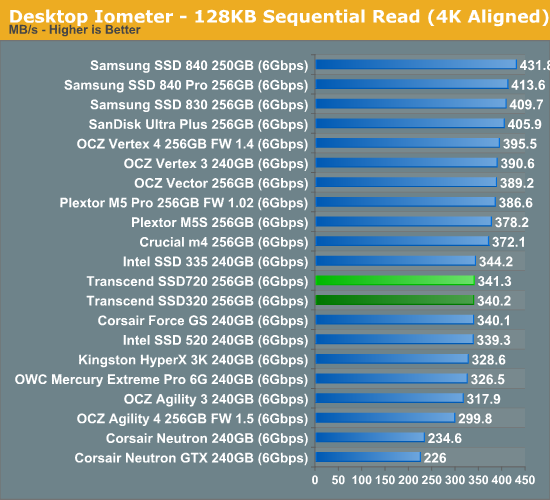
Moving to sequential tests, the SSD720 offers marginally faster write performance than the SSD720.
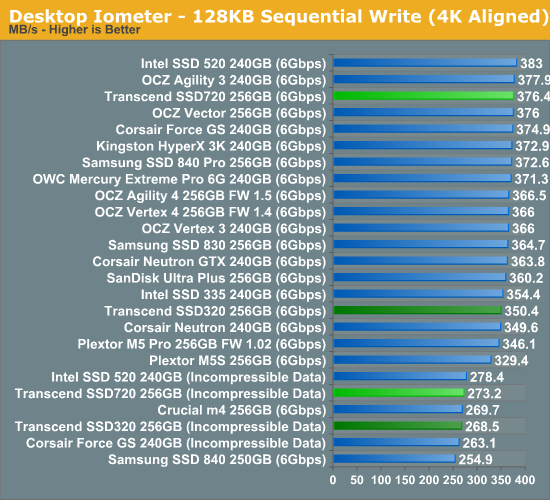
AS-SSD Incompressible Sequential Performance
The AS-SSD sequential benchmark uses incompressible data for all of its transfers. The result is a pretty big reduction in sequential write speed on SandForce based controllers.
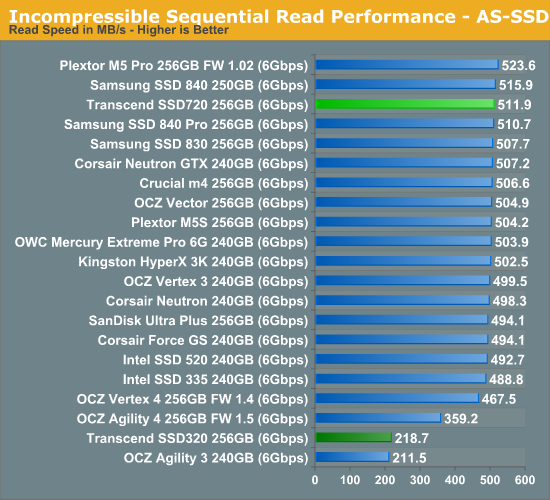
Asynchronous NAND has an enormous impact on incompressible sequential read speed as you can see above. The SSD320 and OCZ's Agility 3, another async NAND based SandForce SSD, perform poorly in this test. It's not a bug or error in our testing as I checked the product specs for the SSD320 and they specified that the maximum read speed for AS-SSD is 220MB/s. When using slower NAND, the performance will be handicapped in scenarios where the NAND is the bottleneck. In this case, the controller and SATA 6Gbps bus are capable of faster throughput but the NAND can't keep up. I believe SandForce's compression adds some overhead as well because the data has to be decompressed -- the Agility 4 with no compression is faster even though it's using async NAND as well.
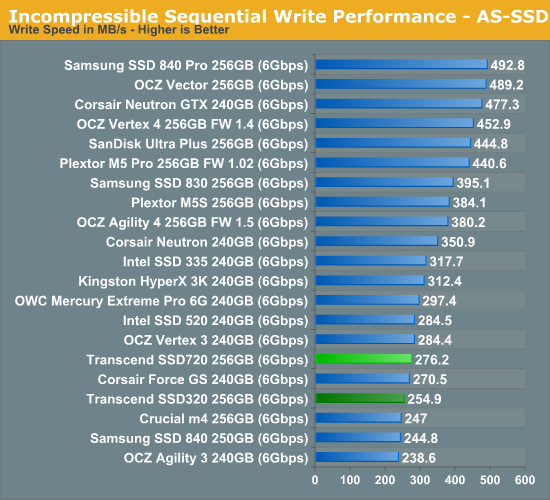










34 Comments
View All Comments
paul878 - Friday, January 25, 2013 - link
For a second I thought they were 320G and 720G drives.Azurael - Friday, January 25, 2013 - link
So what's the difference between a Sandisk Extreme SSD and a Transcend SSD720? How many more identical SSDs can the market support?Flying Goat - Friday, January 25, 2013 - link
If you tried to skip the drives over a lake, you'd find that one was most likely designed with aerodynamics in mind, while the other was not. Sadly, we're just never going to see the sort of truly complete feature comparison at AnandTech that covers that sort of thing. :)gammaray - Friday, January 25, 2013 - link
i dont know, but i got the SanDisk extreme 240gb home and its ultra fast and paid 160$ on sale for it :Dembzyk - Sunday, January 27, 2013 - link
9.5mm vs 7mm heightEgg - Friday, January 25, 2013 - link
The Transcend SSD720 256GB achieves a busy time of just over half that of the Samsung SSD 840 Pro 256GB, and it's missing a decimal place.This seems highly suspect.
Kristian Vättö - Saturday, January 26, 2013 - link
Oh, you're right, there was a typo. It should've been 362 instead of 162. Fixed! :-)iwod - Friday, January 25, 2013 - link
SSD1st Gen - SATA ; Response Time Reduction Compared to HDD
2nd Gen - SATA II; Higher Seq Read Write
3rd Gen - SATA II; Better Random IO
4th Gen - SATA III; Overall Improvement to both Seq and Random
5th Gen? I think Next Gen we need SATA Express and something similar to Intel's Consistent I/O Performance.
Tech-Curious - Saturday, January 26, 2013 - link
Eh, there's still a fair amount of head room on the SATA 3 interface. Wouldn't expect PCIe to become the norm for at least another two generations.Tech-Curious - Saturday, January 26, 2013 - link
Sorry, misread your comment, iwod. Still, even if sequential speeds remain more or less stagnant, there's a lot of room left to improve random read/write with SATA 3.